Mysterious Spike In Radioactivity Over Northern Europe, Accident At Russian Nuclear Plant Suspected
KEY POINTS
- Scandinavian watchdogs detected a mysterious spike in radioactivity levels over northern Europe
- A Dutch agency noted that the source is possibly from nuclear plants in Russia
- The radiation levels are not considered harmful to human health and the environment
- A spokesperson denied that there were any problems at Russian nuclear plants
Watchdog agencies last week detected an increase in radioactivity levels in the atmosphere over northern Europe, suggesting a potential damage at a nuclear plant. Authorities noted the possibility that the spike may be the result of accidental release of radioactive material from one of the nuclear plants in Russia, but a spokesman denied any problems with the Russian power plants.
Several Scandinavian watchdog agencies detected elevated levels of radionuclides cesium-134, cesium -137 and ruthenium-103 over parts of Finland, southern Scandinavia and the Arctic. Although the levels are not considered harmful to human health and the environment, radionuclides are artificial, unstable byproducts of nuclear fission, suggesting that the sudden increase in levels may have resulted from a damage in a nuclear power plant.
According to the Associated Press (AP), the Swedish Radiation Safety Authority noted Tuesday (June 24) that locating the origin of the radionuclides is "not possible" but by Friday, the National Institute for Public Health and the Environment in the Netherlands announced that calculations revealed that the radionuclides may actually have come from the direction of Western Russia.
In a tweet, the Executive Secretary of the Comprehensive Nuclear-Test-Ban Treaty Organization, Lassina Zerbo, shared a map of the possible source of the radiation although a specific location was not pinpointed.
22 /23 June 2020, RN #IMS station SEP63 #Sweden🇸🇪 detected 3isotopes; Cs-134, Cs-137 & Ru-103 associated w/Nuclear fission @ higher[ ] than usual levels (but not harmful for human health). The possible source region in the 72h preceding detection is shown in orange on the map. pic.twitter.com/ZeGsJa21TN
— Lassina Zerbo (@SinaZerbo) June 26, 2020
However, an unnamed spokesman from the Russian nuclear power operator Rosenergoatom denied that there were any problems with the nuclear plants in the region. In fact, the spokesperson said that the radiation levels at the power stations in the area do not exceed normal background radiation figures.
"Both stations are working in normal regime. There have been no complaints about the equipment's work," the spokesman told Russian news agency, TASS. "Aggregated emissions of all specified isotopes in the above-mentioned period did not exceed the reference numbers. No incidents related to release of radionuclide outside containment structures have been reported."
In 1986, it was a similar detection in Sweden that contributed to the reveal that a disaster had occurred in Chernobyl. Specifically, one of the Swedish nuclear power plant employees logged high levels of radiation from his shoes upon coming back from the restroom. Concerned that an accident may have occurred at the facility, employees completed a thorough scan of the facility but, they found that the radiation was actually coming from Chernobyl.
That evening of April 28, 1986, two days after the disaster, Soviet authorities announced that there had been an accident at Chernobyl.
Similarly, a cloud of radiation was detected over Europe in late September 2017 and was suspected to be the result of a nuclear accident in Russia. At that time too the Russians had denied there was any accidental release of radioactivity from one of their plants.
Just this year, there was also another detection of radiation levels coming from a mysterious source, this time at a vacant lot in Indonesia. At the time, authorities focused on clearing the area as the lot was near a housing complex.

© Copyright IBTimes 2024. All rights reserved.






















